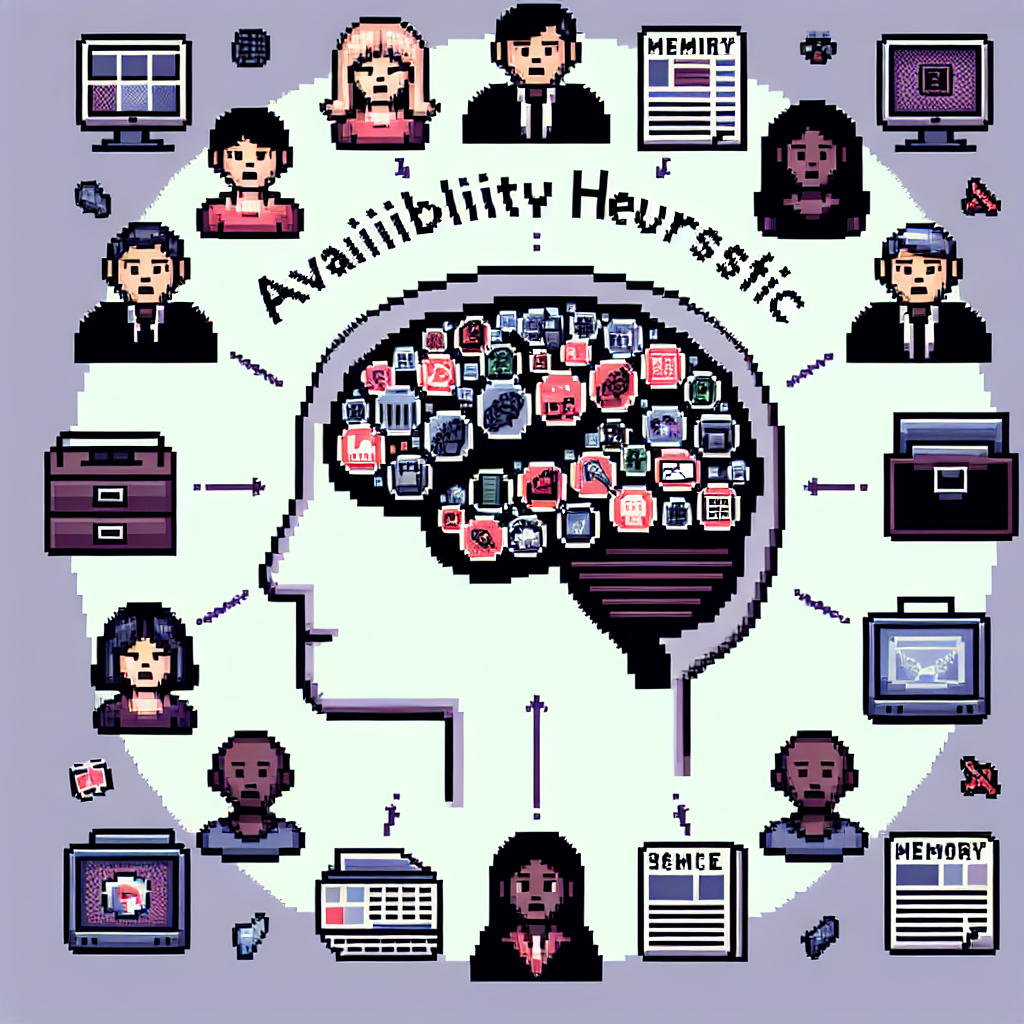Understanding the Availability Heuristic
Explanation of the Availability Heuristic
The Availability Heuristic is a cognitive bias that influences our decision-making by relying on immediate examples that come to our mind. Despite its efficiency in allowing quick judgments, it can lead to errors because it often depends on the ease with which instances are recalled. This means more recent or vivid memories might have an outsized impact on our decisions.
Importance of Understanding this Cognitive Bias in Decision-Making
Understanding the Availability Heuristic is crucial for improving decision-making processes. By becoming aware of this bias, individuals can strive for more balanced decisions, rather than being swayed by the most immediately accessible memories. Decision-makers in various fields, like business or policy-making, benefit greatly from recognizing how this heuristic affects judgments and enhances critical evaluation to mitigate its impact. Additionally, it aids personal growth by encouraging less impulsive choices in everyday life.
Understanding the Availability Heuristic: Origins and Psychological Foundation
Psychological Foundation
The Availability Heuristic is a cognitive shortcut that relies on immediate examples that come to a person’s mind when evaluating a specific topic, concept, method, or decision. It stems from a psychological need for efficiency due to limited cognitive resources. Cognitive psychologists Amos Tversky and Daniel Kahneman explored this heuristic to understand how people make quick judgments.
Studies and Experiments
Research, including groundbreaking experiments by Tversky and Kahneman, illustrates how the brain often prioritizes recent, striking, or easily recalled experiences. These studies demonstrate that people tend to overestimate the importance or frequency of events that are vivid or emotionally charged. For example, individuals may misjudge the frequency of dramatic events such as plane crashes, largely because these events are heavily reported in the media. As a result, the Availability Heuristic influences decision-making, sometimes leading to skewed perceptions and choices. Exploring these origins helps to shed light on the powerful impact of this heuristic in shaping our thoughts and decisions.
The Availability Heuristic and Its Mechanics
How Our Brains Process Information
Our brains rely on the Availability Heuristic to make quick decisions by focusing on information that is immediately available. This cognitive shortcut can be useful because it allows us to process vast amounts of data rapidly. However, it can also lead to errors if the most readily available information is not accurate or is overly emphasized. For instance, during decision-making, we might recall recent events more easily, making them seem more significant than they actually are.
Role of Memory and Recall
The Availability Heuristic heavily depends on our memory, as it prioritizes information that is easy to recall. This means that vivid memories often have more impact on our decisions than statistical data or less memorable events. Additionally, the frequency with which we encounter particular information increases its recall, further influencing our judgments and perceived importance of certain issues.
Impact of Recent Information
Recent events play a significant role because they are fresh in our minds. This can skew our perception of risks and probabilities, leading us to overestimate or underestimate the likelihood of events. For instance, if a dramatic event occurs, such as a natural disaster or a high-profile crime, it is likely to dominate our thoughts and affect our subsequent decisions. The immediate recall of such events strengthens the influence of the Availability Heuristic in our daily lives, often at the expense of a more balanced understanding of reality.
Understanding the Availability Heuristic
Everyday Decision-Making Scenarios
The Availability Heuristic often plays a critical role in our daily choices, where the ease of recalling specific events or information can heavily impact decisions. For instance, someone might overestimate the danger of plane travel right after hearing about a well-publicized air accident. This is because the incident is fresh in mind, even if statistically, flying remains one of the safest transportation modes.
Influence on Public Opinion and Media Reporting
In the sphere of media, the Availability Heuristic significantly influences public perception. Stories that are covered prominently can lead to skewed understandings of reality. During times of intense media coverage of crime, people might believe crime rates are rising, despite statistical evidence to the contrary. This highlights the importance of critical media consumption to avoid being swayed merely by recent or frequent exposures.
Impact of the Availability Heuristic on Society
Economic and Business Decisions
The Availability Heuristic can significantly impact economic and business decisions by influencing how readily people recall particular events. Because of this, business leaders might focus on recent high-profile failures, affecting their decision-making processes. Despite being aware of this bias, companies often fall into the trap of prioritizing immediate information over historical data. Additionally, understanding this bias is crucial for developing strategies that counteract its effects.
Legal and Policy Implications
During legislative debates, the Availability Heuristic often sways opinions, leading to policy decisions that may not align with empirical evidence. Moreover, policymakers need to recognize the influence of recent and vivid incidents on their judgments to ensure balanced and informed decisions. This recognition helps mitigate unnecessary risks and promote more equitable solutions.
Effects on Personal Behavior and Relationships
In personal contexts, individuals may rely on what’s most readily available in memory, which affects their relationships and daily interactions. Furthermore, by acknowledging the presence of the Availability Heuristic, people can work towards developing healthier communication patterns and more rational responses. Encouraging a broader evaluation of situations can enhance understanding and improve relationship dynamics.
The Availability Heuristic in the Digital Age
Influence of Social Media and Online News
The Availability Heuristic plays a significant role in how individuals perceive and process information, especially in today’s saturated digital environment. During our daily interactions with social media platforms, we are frequently exposed to content that may not fully represent broader realities because these platforms prioritize engagement. As a result, people tend to judge the frequency or likelihood of an event based on its presence in their feeds, rather than its actual occurrence. This is particularly crucial when considering the speed and spread of online news, which often highlights dramatic and rare events.
Digital Platforms’ Role in Reinforcing Bias
Furthermore, digital platforms reinforce this bias by using algorithms that amplify the most sensational stories, making them more accessible through likes, shares, and comments. Despite this challenge, it’s possible to counteract the impact of the Availability Heuristic. Users can adopt strategies such as questioning the prevalence of the information they consume and seeking out data or reports from a variety of sources to obtain a more well-rounded perspective. Additionaly, by prioritizing these practices, individuals can navigate the digital landscape more effectively, reducing the influence of cognitive biases on their decision-making.
Strategies to Mitigate the Availability Heuristic
Case Study: Enhancing Information Literacy to Combat Bias
In the modern era, the Availability Heuristic plays a significant role in shaping public perception. In the corporate world, however, it often leads to skewed decision-making, primarily when executives rely heavily on recent market trends rather than comprehensive data analysis. A well-documented case involved a multinational corporation that faced substantial losses because management decisions were driven by prevalent news stories about stock market volatility, instead of focusing on long-term financial data. The influence of this cognitive bias was profound, resulting in hasty investments and strategic blunders that cost the company millions.
To address this issue, the company initiated an information literacy program aimed at enhancing critical thinking skills among its management team. Workshops were conducted to train executives in effective data analysis methods, emphasizing the importance of considering a broader range of information sources before making crucial decisions. Moreover, a comprehensive media literacy curriculum was developed, encouraging the team to engage with diverse perspectives and question the reliability of single-source narratives.
As a result, the company saw a marked improvement in its decision-making processes. Long-term strategies were developed with rigorous data analysis, leading to more sustainable growth. Furthermore, the shift in company culture towards valuing diverse perspectives fostered a more innovative environment. The changes implemented by the corporation demonstrate how a structured approach to enhancing information literacy can effectively mitigate the impact of the Availability Heuristic, enabling organizations to make more informed and balanced decisions.


